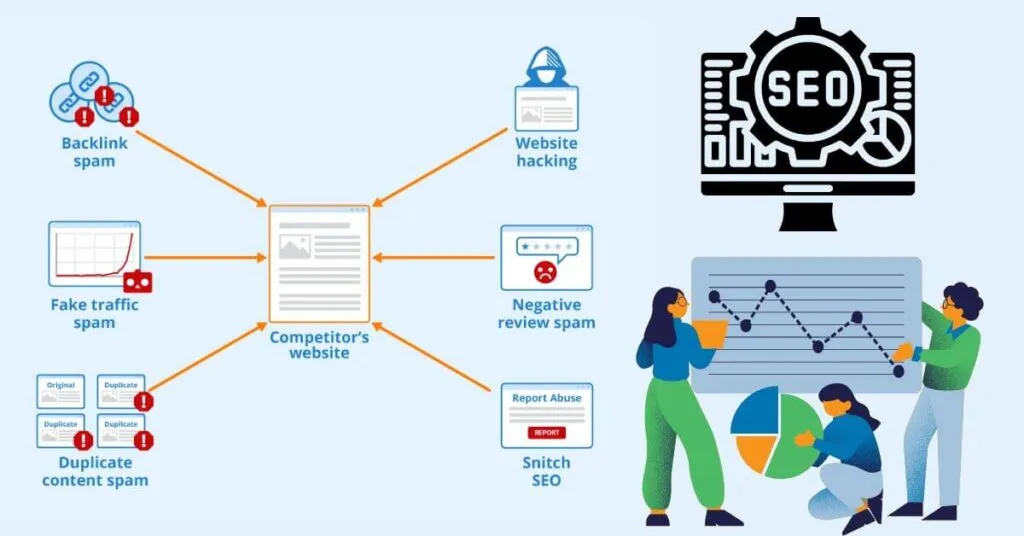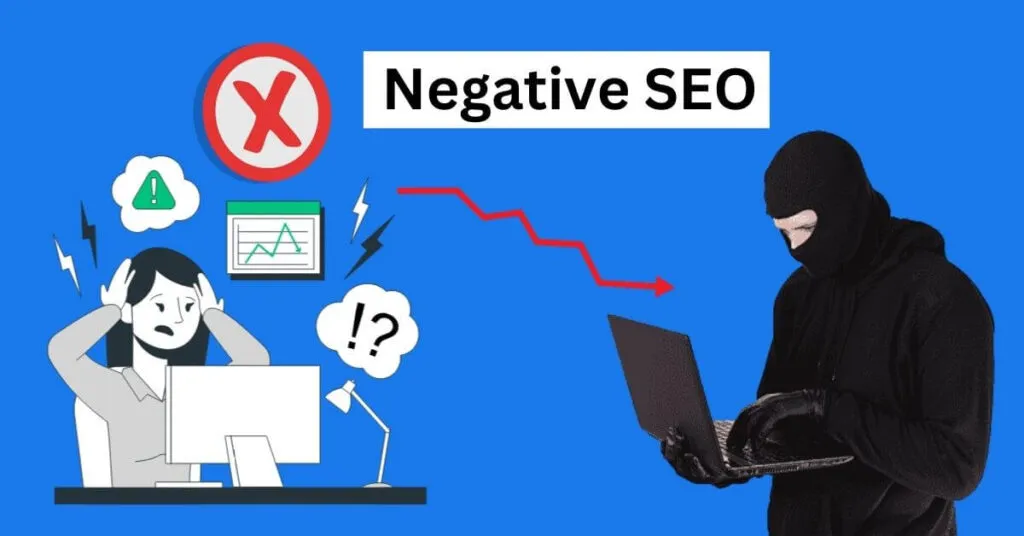Negative SEO Explained – Positioning a website on search engines requires know-how and above all a lot of time. Your competitors know this well and some of them may try to impact the natural referencing of your site with Negative SEO rather than wanting to push theirs in the search engine results.
Table of Contents
Introducing Negative SEO
Negative SEO (NSEO) includes a whole set of natural referencing techniques aimed at making a website fall in the search results. In the vast majority of cases, it is the competitors themselves who carry out this attack.Quality referencingon their website associated with Negative SEO attacks gives your competitor every chance to come and position themselves in front of you in the search engine results.
This method is not new, many websites have been victims of Negative SEO attacks and this since the beginning of the internet. Such an attack wastes a lot of time and money to be repaired.
The Main Techniques of Negative SEO
It is easier to fight against these Negative SEO (NSEO) attacks when you know the techniques they use. Search engines are constantly improving their algorithms, especially Google, in order to rank the most relevant and quality websites at the top of the results.
Websites that do not respect the search engine guidelines will be poorly positioned in the SERPs. To impact your natural referencing, the competitor will call on an unscrupulous SEO who will be inspired by the penalty factors to apply them to your website.

I have gathered together for you some practices that search engines penalize:
- duplicate content
- SEO over-optimized content
- external links in bulk
- irrelevant links
- 301 redirects carrying penalties
- Server slowdown
- The comment bombing
- Cloaking and spamdexing
- etc.
To ruin all your SEO and all the work it took to get there, your attacker will implement all these bad practices. He will point thousands or even hundreds of thousands of very poor quality external links, he will also be able to copy your content and publish it en masse on the web.
If your website were to be hacked, he will be able to modify the content of your pages to reduce its quality level, he will also have the possibility of modifying the website files to practice spamdexing. All this, without you knowing it!
In addition to penalizing your website, the competitor behind this attack may try to destroy your e-reputation. To do this, he will report your website to Google via his spam report, he may also have a significant number of fake profiles on the majority of social networks to harm you. I’ll stop there because the list may be even longer.
How do I know if my website is affected?
Before you immediately cry out about Negative SEO (NSEO), there are signs that can tell you whether or not you have been the victim of an attack.
- your site has suffered an unfounded drop in search results, which has led to a drop in your organic traffic.
- you have received an alert from Google on Search Console (formerly Webmasters Tools) informing you that your website does not comply with good natural referencing practices.
- your pages are inaccessible
- the number of 404 errors has significantly increased
- your site has received a penalty from Google
If you don’t identify any of these signals, there is no need to panic.
How to Protect a Negative SEO Attack?
When your website has been the victim of a Negative SEO attack, the first thing to do is to secure your server. Regardless of whether the hacker has modified your site or not, it is important to secure the server so that the hacker does not come back.
Indeed, if you do not secure your server, the hacker will be able to enter more easily by connecting to your server to attack your website again. Then, delete the unwanted content present on your website. Call on a specialized company if you do not have the required skills. It would also be possible to change hosts for one that is more secure.
If you don’t want to be attacked again, you should avoid choosing a Low Cost hosting provider because they don’t have very advanced security measures. Also update all the plugins or modules that your website uses, you reduce the risks of a new attack. If your website runs on WordPress, you increase the chances of being attacked again if you don’t update them.
Your security vulnerability is fixed, now check if:
- robots.txt does not block access to Google
- your website code no longer contains harmful materials
- the content of your website
NOTE: Do not use keywords that could be related to spam such as money site, adult site and other online pharmacy.
How to remove spammy links?
With the help of online tools like Ahrefs, Majestic SEO or Open site explorer, we will be able to analyze where your spammy backlinks come from. The backlinks that you should remove as a priority are those that have an anchor that is too long or over-optimized.
Now that you know which links to remove , send an email to the websites in question so that they remove their links. If your messages remain unanswered, you will have to “disavow” them using Google Search Console. To do this, go to the Google disavow link tool and select the site for which you want to manage the backlinks to disavow:
Select the website you want to disavow links from. Google will then display a warning message before you can continue: This is an advanced feature that should be used with caution. If used incorrectly, it can hurt your site’s ranking in Google search results. We recommend that you only disavow inbound links if you believe that there are many low-quality, spammy, or artificial links pointing to your site, and you are convinced that these links are problematic.

Pradeep Sharma is a author the mind behind Techjustify, where I craft insightful blogs on technology, digital tools, gaming, AI, and beyond. With years of experience in digital marketing and a passion for tech innovation, I aim to simplify complex topics for readers worldwide.
My mission is to empower individuals with practical knowledge and up-to-date insights, helping them make informed decisions in the ever-evolving digital landscape.




